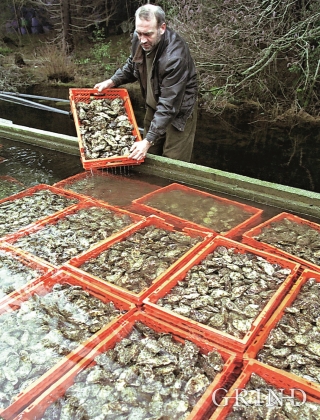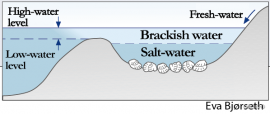Published: 25.07.2015 | Author: Endre Skaar
Oyster farmer Alf-Roald Sætre of the Espevik dam with a case full of oysters. As far back as the Middle Ages, oysters have been considered luxury food for rich Norwegians. A Norwegian law from 1276 states the following requirement, in a chapter on the fishing industry: "Fresh salmon and other fresh fish and oysters shall be purchased on the boats or on the docks but not from shops." (Ørjan Deisz)
The northern European oyster has been a popular food for thousands of years, and many countries, especially France, England and Holland, have long traditions of raising this shellfish. In Scandinavia it is first and foremost in Lim Fjord on Jylland that there has been large scale oyster production.
In Norway, the company "Selskabet for de Norske Fiskeriers Fremme" set up oyster farming several places along the coast during the 1920s. For many, this was quite a lucrative extra income. In Hordaland there was oyster farming from oyster dams at Tysnes during the previous Century (i.e. at Espevikpollen and Seløya), in Os, Fana (Kviturdspollen) and Lindås, as well as at Bømlo. The oyster plant at Tysnes was the first one; it was in operation already at the end of the 1800s. Continuing until today, it is only the Espevik dam atTysnes and the Aga dam at Bømlo that deliver oysters. Most of the production takes place in land-based tanks, but the mother oyster is collected from the dams. The oysters from Hordaland are used in the first instance only for consumption in this country.
Oysters are native to our coast, but they were more common in earlier times, when the sea temperature was somewhat higher. The biggest problem with oyster farming is that reproduction is affected if the water temperature falls much below 18°C. The best environments for oysters to live and grow up is therefore in small, protected dams where the water temperature can be warmer than in the open sea.
The Pacific oyster has also become more established in Hordaland during recent years. This is a foreign species from America that is unwanted in Norwegian nature, but its spread is almost impossible to prevent. It is not known what consequence this will have for our own oysters or other indigenous species.
A typical oyster dam is from fifty to several hundred metres broad and has a narrow and shallow opening. Ideally, a small stream should run out into the dam, big enough to give the upper water layer a lower salt content than the water lower down toward the bottom. The fresh water mixes negligibly with the saltwater under thus creating a stable brackish water layer at the top. This protects the seawater beneath from contact with the air. During the day, the sun shines through the brackish water layer and warms up the sea water beneath. When it cools down at night, the heat loss is only from the surface. In this way, the brackish water layer functions like the glass in a greenhouse. The sea water underneath becomes quite warm, and the temperature here can be over 30°C.




